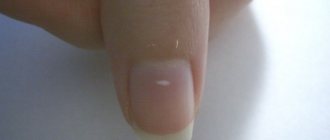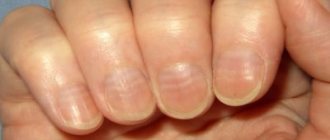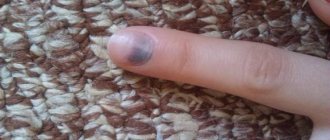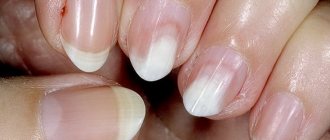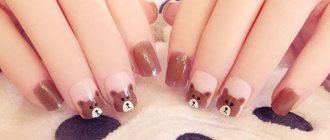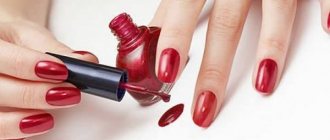Why do stripes appear on fingernails?
Longitudinal stripes on nails are a common occurrence in people of all ages. However, not everyone pays attention to the body’s reaction and waits for the defect to disappear on its own. The stripes usually develop from small spots, gradually growing in different directions. With more serious diseases, the nail plate begins to deform and take on a wave-like shape.
There are various reasons for the appearance of stripes, among them there are both minor factors and serious deviations:
- Improperly performed manicure, in particular damage to the cuticle area.
- Unbalanced food intake, lack of vitamins, impaired metabolism, excessive consumption of carbohydrates, deficiency of iron and B vitamins.
- Disturbances of the endocrine system. For this reason, the problem often appears in overweight people and people with diabetes.
- Destructive processes in the nervous system.
- Skin diseases.
- Unsuccessful nail extensions, as chemicals destroy the structure of the plate.
- Diseases of the stomach and intestines.
- Problems with blood circulation.
- Experienced stress or strain (psychological or physical).
- Recent serious illness (jaundice, influenza, scarlet fever).
- Nail injury that distorts the plate.
Injuries cause the appearance of longitudinal stripes on the nails for a short time
It should be remembered that changes in the structure of the nail are not always a sign of disease. This phenomenon can be observed as a result of age-related changes and hormonal imbalances.
Types of diseases that cause stripes to appear on fingernails
The appearance of longitudinal stripes on the nail is called leukonychia. Pathology can appear gradually with white spots and bumps or affect the area suddenly.
Diseases in which such a symptom appears are of a different nature. The first group of pathologies is in the nature of fungal infections of the nail plate. It may appear after an unsuccessful manicure, when infected from another person, if the patient has skin diseases, for example, psoriasis.

A characteristic symptom of a fungal infection is itching around the nail, brittleness and burning. In addition to white, nails can be painted black. Dermatological problems also include infection with lichen planus, the development of rheumatoid arthritis or gout.
As a result of chemotherapy and the development of malignant tumors, the human body suffers from vitamin deficiency. For this reason, white lines are often observed in cancer patients. If the stripe turns blue, then the root of the problem lies in liver disease.
Red streaks are the result of hemorrhage within the nail tissue. The reason is blockage of blood vessels and blood clots, which in turn appear along with problems of the cardiovascular system. When such stripes appear, the heart must be examined first.
White stripes often appear after bruises and blows (they can also be red), as a result of a long diet or poor hygiene. If nothing bothers a person other than a change in color, then the problem can be solved with proper nutrition and preventive measures.
Yellow spots may appear on the nails. This indicates pathologies of the liver and kidneys, vitamin deficiency, and a violation of the integrity of the nail matrix. Also, yellow furrows may appear in response to the body's reaction after taking specific medications, prolonged smoking and working with chemicals.
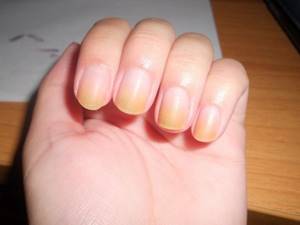
Longitudinal stripes on brown nails can form as a result of injuries and bruises. In this case there is no cause for concern. If the furrows appear spontaneously, perhaps the cause lies in the pathology of the adrenal glands, hemochromatosis or arsenic poisoning. If the brown spot quickly grows and covers the entire surface of the nail, the cause may be melanoma.
The most serious disorders are characterized by the appearance of black bumps. The cause is many factors: diseases of the cardiovascular system, pathologies of the gastrointestinal tract, fungal diseases, arthritis, trichinosis, reaction to taking medications. In some cases, the black color indicates frozen blood clots under the nail, formed after an injury.
In old age, the appearance of black stripes can be explained by the development of vascular atherosclerosis.
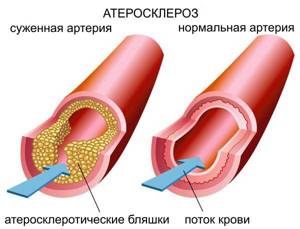
The formation of grooves on the nails cannot be ignored, as it is often a signal of diseases of various body systems. Even if the stripes disappear on their own, there is no guarantee that they will not appear again.
Perhaps it's a fungus
Black stripes under the nails can also be a common fungus. To confirm the presence of the latter on the nails, you should go to the hospital. There, with the help of laboratory tests, they will quickly determine what kind of fungus it is, and the attending physician will explain in detail how to get rid of it. At the end of the treatment, you can completely get rid of the black stripes under your nails once and for all.
Quite often, the fungus affects the fingernails and toenails after visiting places such as a sauna, bathhouse and swimming pool, or public transport. In other words, if you have a weak immune system, you can catch the fungus anywhere.
Sometimes people notice that black spots on their nails appear after a manicure done by a specialist. This may be due to the fact that the technician handled the scissors or files poorly and gave you an infection. In this case, you should choose manicurists very carefully and go only to those specialists in whom you are absolutely confident.
Diagnosis of the formation of longitudinal stripes on nails
First of all, diagnosis consists of an external examination of the nail plate. The doctor asks the patient about other symptoms and reasons after which the nail began to deform.
After analysis, the following studies are prescribed:
- analysis for fungal infection and other pathologies of the nail plate;
- a nail biopsy, during which a small amount of tissue is taken from the formed strips for examination;
- complete blood count to confirm or rule out other diseases;
- Ultrasound of internal organs (focus on the liver);
- diagnosis of the state of the cardiovascular system, since discoloration of nails and furrows often appear due to heart problems.
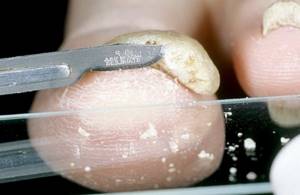
Testing for fungal infection and a biopsy of the nail plate are carried out in dermatological clinics. The cost of analysis is from 820 rubles, biopsy – from 500 rubles. The cost of a full ultrasound of internal organs starts from 1,500 rubles.
When to see a doctor
Longitudinal stripes on nails do not always signal cosmetic problems, but may be one of the symptoms of damage to the human body. For this reason, you cannot self-medicate and wait until the irregularities disappear on their own.
In addition to the appearance of furrows, the following symptoms should alert the patient: change in color of the nail plate, poor health, hair loss, deterioration in concentration, irritability, headaches. First of all, the patient undergoes a consultation with a therapist, who prescribes general tests.
If the reason for the appearance of longitudinal stripes lies in diseases of the internal organs, then the patient is referred to see the following specialists:
- gastroenterologist;
- dermatologist;
- neurologist;
- infectious disease specialist;
- cardiologist;
- immunologist;
- endocrinologist
Description of the problem
Pronounced nail protrusion usually does not cause concern for people. However, in order to avoid aggravating possible complications, it is better to take care of solving this problem in advance. If the nail bed does not have a uniform, smooth surface,
and dotted with vertical or horizontal stripes, layers or cracks - this is the ribbing of the nails
.

- Vertical ribbing
- a groove
extends from the base of the nail bed to the free edge
. It can be in the form of a dense structure or several rare grooves. The stripes may have the appearance of a bend, distortion of the smooth surface of the nail, have a clearly defined fracture structure or layering of keratinized nail matter. - Horizontal ribbing
-
pits and grooves run from the side to the center of They can be intermittent, semicircular, thin or clear. The stripes can end in the middle of the nail plane, or they can cross it completely.
If your nail plate does not have a smooth surface, then be sure to pay attention to the nature of the irregularities, study the structure to correctly assess the problem, and take steps to correct the situation.
Prevention of the formation of longitudinal stripes on nails
To prevent the appearance of furrows from exposure to external factors, it is recommended to adhere to the following rules as a preventive measure:
- avoid mechanical deformation of the nail plate and the skin around it;
- maintain general hygiene;
- use shoes when visiting places with large crowds of people and shared showers (beach, gym, bathhouse, swimming pool);
- do a manicure with sterile instruments, carefully work with the cuticle so as not to damage the deep layers of the skin;

- wash your hands after visiting the street and public transport;
- do not bite your nails and trim them regularly;
- choose shoes that fit properly;
- avoid contact with aggressive acids, use protective gloves when using household chemicals;
- do not be nervous.
Treatment methods for longitudinal stripes on nails
Treatment is prescribed based on the results obtained and consists of complex therapy. In addition to medications, you need to take vitamins, which are prescribed individually. However, in most cases, leukonychia causes temporary cosmetic discomfort, which goes away on its own after some time.
Medications
The choice of therapy is based on the diagnosis. Depending on the cause of leukonychia, medications can be used for different groups of organs.
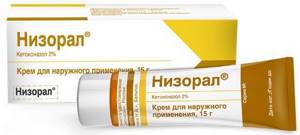
| Antifungal | General strengthening | Hepatoprotectors | Means to improve heart function |
| Nizoral. Available in cream form. Widely used to treat skin diseases and fungal infections. The nail plate is treated once a day. The course of treatment is 2-4 weeks. Price from 385 rub. | Vitamin B12 (methylcobalamin). Available in tablet form. Strengthens the immune system and nervous system, saturates the body with essential elements, and increases physical endurance. You need to take 1 tablet per day. Price from 430 rub. | Karsil. Available in tablet form. Used to treat liver pathologies. Take 2 tablets 2 times a day. The course of treatment is up to 3 months. Price from 305 rub. | Amiodarone is an antiarrhythmic drug. Available in tablet form. It is used to treat cardiovascular pathologies of varying severity. For the first 10 days, the patient is prescribed to take 1 tablet three times a day. Then take 1 tablet every other day. Duration of treatment is 25-40 days. Price from 96 rub. |
| Clotrimazole. An effective antifungal agent produced in the form of an ointment. The cream is applied to the affected area 2-3 times a day. The course of treatment is 3-4 weeks. Price from 50 rub. | Biotin. It has a positive effect on metabolic processes, strengthens the body’s protective function and restores vitamin balance. Take 1 tablet per day. The duration of treatment is at least a month. Price from 115 rub. | Essentiale. Available in capsule form. Widely used to treat liver diseases. Use 2 capsules three times a day. Duration of treatment is at least 3 months. | Vinoxin is a vasodilator drug. Tablets are prescribed to normalize the functioning of the central nervous system, as well as to strengthen blood vessels. Take 1 tablet twice a day. Duration of treatment is 15-20 days. Price from 170 rub. |
| Lamisil. Available in ointment form. It has a wide spectrum of action in the fight against fungal infections of the skin and nails. Worn to the site 1-2 times a day. Treatment duration is 10-14 days. Price from 226 rub. | Cardiomagnyl is a blood-thinning drug used to treat cardiovascular diseases. Take 1 tablet per day. If the pathology is chronic, then the drug is prescribed for long-term use. In other cases, the course of treatment is about 3 months. Price from 160 rub. |
Traditional methods
In addition to taking medications, it would not be superfluous to strengthen the nail plate through the use of traditional medicine. Using medicinal herbs and essential oils helps strengthen and heal nails.
- Sea salt. To prepare the bath, you need to dissolve 2 tsp. sea salt in 1 liter of warm water. If the patient does not have allergies, it is recommended to add a few drops of essential oil (chamomile, lemon, sandalwood or tea tree) to the solution. Hands are kept in the bath for 25 minutes, then soaked with a towel and moisturizer is applied.

- Sea salt and baking soda . Both ingredients are taken in equal proportions and dissolved in hot water. Keep your fingers in the solution for 15-20 minutes. The procedure is performed every day, the components help strengthen the nail plate and destroy pathogenic bacteria.
- Nail bath using almond, bergamot, grapefruit and ylang-ylang oils. You need to take 4 tbsp. l. almond oil and 6 drops of other components. Keep your fingers in the solution for about 25 minutes. It is recommended to repeat the procedure several times a week until complete recovery.
- A solution based on oak bark and chamomile. Herbs are taken in equal proportions, poured with boiling water and infused for 30 minutes. The procedure is repeated daily for 20 minutes. This decoction has an anti-inflammatory and healing effect.
Other methods
An effective procedure aimed at eliminating longitudinal stripes is paraffin therapy. It helps strengthen nails and also has a positive effect on the appearance of the skin. The procedure is carried out in a salon, where liquid paraffin is applied to the area of the hands and left for 20-30 minutes. After time has passed, the composition is carefully removed from your hands.
Wax helps restore shine and smoothness to nails. It is recommended to carry out a course of 3-4 procedures. It should be remembered that after paraffin therapy you cannot paint your nails with varnish for 14 days.
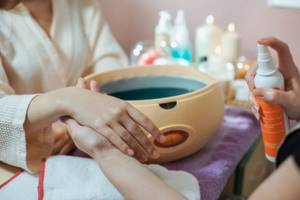
Nail polishing is one of the most effective salon procedures. To do this, the master takes several special tools with abrasive attachments. In this way, you can get rid of furrows in several sessions (1 session per week).
However, experts do not recommend using polishing as an independent treatment. Ignoring a comprehensive approach may result in the reappearance of stripes.
Nail polishing steps:
- A specialist uses an abrasive attachment to carefully remove the top deformed layer.
- The nail plate is polished using a sanding file, which corrects unevenness.
- Using a soft polishing attachment, a smooth nail plate is formed.
- Finally, a protective agent and therapeutic strengthening composition with keratin are applied. If necessary, the cuticle can be additionally processed.
An additional method of treating longitudinal stripes on nails is following a diet. It is necessary to create a diet so that a sufficient amount of B vitamins, zinc and iron enters the body with food. A prerequisite is to drink at least 2 liters of clean water per day.
The menu should include the following products:
- cereals (buckwheat, rice, millet, oatmeal);
- bread;
- vegetables (beets, cabbage, tomatoes), herbs, fruits (apple, banana, apricot, kiwi, lemon);
- eggs;
- cheese and cottage cheese;
- lean meat;
- fish;
- dried fruits;
- nuts.
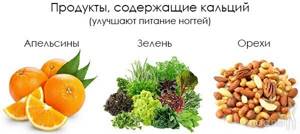
It is strictly forbidden to eat fatty and fried foods, fast food and large amounts of sweets.
Skin diseases
When working with a client, a manicurist needs to remember that there are various skin diseases, including infectious ones , which must be able to be identified by appearance. Of course, you should not work with people who have infectious (contagious) diseases due to the danger of their spreading over a larger area and becoming infected.
Infectious diseases
Pustular diseases
The most common skin diseases. They are caused by staphylococcal and streptococcal microbes and are characterized by the presence of abrasions, ulcers, and yellow crusts on the skin of the hands and other parts of the body, under which there is purulent discharge.
Boils, folliculitis
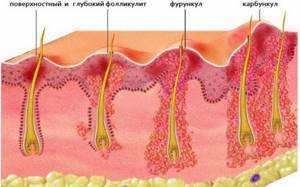
Purulent inflammation of the hair follicles (sacs) or sebaceous glands. In these cases, painful red nodes appear on the skin, in the center of which after 3-5 days a purulent “core” appears.
Inflammation of the nail folds
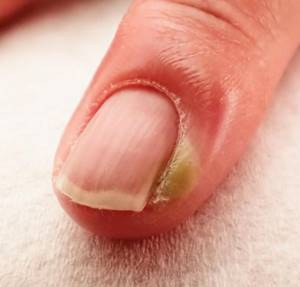
Swelling, redness, and pain in the skin surrounding the nail; purulent contents may be present. This phenomenon is called paronychia (felon)
. It is cured within a short time, but sometimes the participation of a surgeon is required. When treating such a finger, do not touch the inflamed area. You can recommend the client salt baths and heparin-containing ointments and gels to relieve swelling. Vishnevsky's liniment and levomekol can be applied at night under a bandage.
Erysipelas

An acute infectious disease caused by streptococcus. It most often occurs on the legs, but can also affect the skin of the hands. The clinical picture is as follows: bright redness, swelling with unclear borders similar to tongues of fire, pain. The skin is hot to the touch. May have a peripheral ridge.
Mycoses
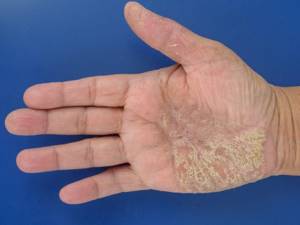
Diseases caused by different types of pathogenic fungi. Mycoses of the hands are manifested by thickening of the skin, peeling, especially in the skin furrows against the background of slight redness. Often the lesion is limited to raised, scalloped edges. Patients are bothered by itching.
Scabies

A contagious disease caused by the scabies mite. Patients are concerned about itching, especially at night, rashes of small red nodules arranged in pairs, and pinpoint crusts. Typical location: interdigital folds of the hands, wrist area, elbows, as well as the abdomen, genitals, buttocks, and lateral surfaces of the torso.
Human papillomavirus (wart)
Non-inflammatory disease of viral origin. The human papillomavirus most often affects the feet and hands. The disease is transmitted through direct contact or through various objects, so the master should not handle them - there is a risk of accelerated spread. There are different types of warts:
- Vulgar warts
are rough, convex formations with a hard, rounded surface. They are located mainly on the hands.

- Flat warts
are rashes on the back of the hands and in the area of the wrist joints. The shape is different, the color is red-brown, sometimes bluish. - Plantar warts
- located on the soles of the feet, painful, looking like a callus or a small pit. They differ from core calluses in that they are located in soft tissues and are delimited from them by a “side”; they have a structure similar to a bundle of thin tubes.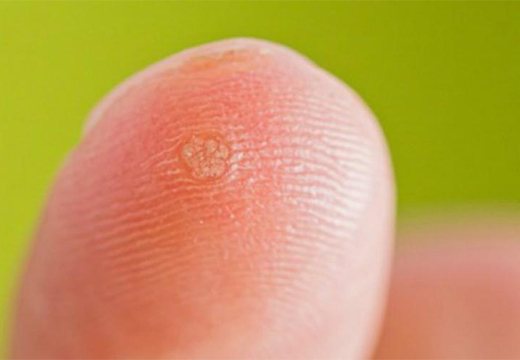
Herpes
Another viral disease that occurs when working with your hands. It has similar signs as when it appears on the nasolabial triangle (nose, oral and nasal mucosa). Manifestations of herpes can accompany a person throughout his life, disappearing and reappearing when immunity declines. Colds, changing seasons, stress, immune system failures are factors that explain the activation of the virus.
Non-infectious skin diseases
Among non-infectious skin diseases, the most common are hangnails, dermatitis, eczema, neurodermatitis and psoriasis.
hangnail
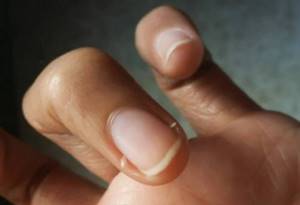
A hangnail (“hanging nail”) is a common condition of the cuticle in the sinus area. Hangnails appear due to too dry cuticles or as a result of improper cutting or biting off a disturbing piece of skin. The situation can be easily corrected by softening the cuticle with oil. This condition is one of the simplest and most common, but carries the threat of infection with possible consequences in the form of panaritium and subsequent onycholysis.
Dermatitis
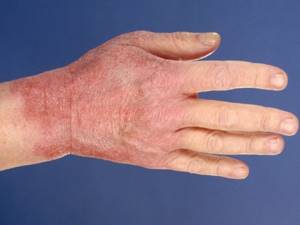
Inflammation of the skin, which can be caused by various reasons. They can be of an allergic nature, due to a person’s increased sensitivity to common chemicals (washing powders, cleaning products, varnishes, paints, etc.). Dermatitis can also be caused by ordinary damaging factors (high temperature, cold, concentrated acids and alkalis, etc.). This disease manifests itself as redness, swelling with clear boundaries, burning, pain. There may be small bubbles or blisters in this background. The disease can be treated under the supervision of a dermatologist.
Eczema
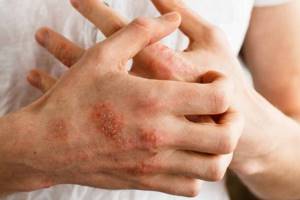
A chronic disease, in the mechanism of which the main role is played by allergies to various internal and external irritants. It manifests itself simultaneously with several signs: redness, swelling, itching, the presence of small blisters and abrasions, nodules. Most often, areas affected by eczema become weeping. Subsequently, thickening of the skin and peeling occurs. The disease usually occurs against the background of diseases of internal organs, stress, and damage to the nervous system.
Neurodermatitis
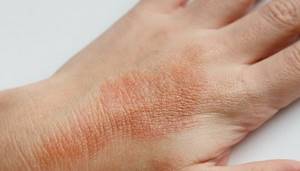
Neurodermatitis (atopic dermatitis) is a genetically determined disease. Occurs in childhood and often recurs. There are areas of redness, thickening, and peeling on the skin of the hands, elbow pits, neck, around the eyes and mouth, and other areas of the skin. The skin pattern is clearly visible. The disease is accompanied by severe itching, so longitudinal abrasions and crusts are visible on the surface of the affected skin. It is necessary to avoid contact of aggressive drugs (alcohols, acetone, alkalis and acids) on the affected area.
Psoriasis
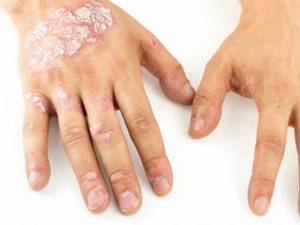
A genetically determined general disease that affects not only the skin, but also joints, kidneys, and liver. It is based on the accelerated reproduction of basal cells of the epidermis, which do not have time to go through all phases of development. The disease can occur at any age. The picture of the disease is as follows: areas of redness, thickening of the skin, covered with silvery scales, appear throughout the skin. They peel off easily, and pinpoint bleeding is found underneath them. The rashes are most often located on the hands, elbows, and scalp.
Pigmentation disorders
Skin conditions associated with pigmentation disorders are not uncommon.
. They can be caused by internal and external reasons, as a result of which an excess or lack of pigment appears in the skin. The function of melanocytes is impaired, the body is more sensitive to ultraviolet radiation. Pigmentation disorders are not a contraindication to nail services.
Well-known examples of such conditions are vitiligo, albinism, chloasma and freckles.
Albinism

Complete absence of pigmentation in the body, including skin, hair, eyes. These people's hair is white. The skin color is pale pink, devoid of any shade. The eyes are pink. When using light-curing materials (gel polish, gel), it is important to apply sunscreen to the skin of the hands up to the middle phalanx of the fingers, avoiding the cuticle area and the nails themselves.
Vitiligo

Characterized by pale pink spots on various areas of the skin.
Chloasma
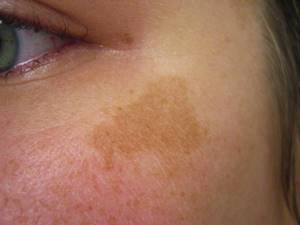
Large brown spots on the skin of the face, neck, and less often in other places.
Freckles
Small brownish spots on the face and body.
Also, hyper- and hypopigmented spots can remain in place of resolved lesions in some skin diseases, after acne, after incorrectly performed cosmetic procedures, during hormonal changes, etc.
When signing up for a procedure, clients often do not warn the specialist about the presence of a particular disease. To organize your work safely and feel confident even when encountering infectious diseases, we recommend that you read the sanitary standards and rules for processing tools.
Possible complications
Leukonychia often resolves without complications. If the cause is identified in time and treatment is started, the nail plate will soon recover, and the risk of recurrent streaks will decrease several times.
In advanced stages, the nail can become completely deformed. In this case, it is completely removed surgically. The new plate will grow in a few months, but during this period it is necessary to monitor the recovery process to ensure that the nail is growing correctly.
Healthy and well-groomed nails bring self-confidence to a person. Therefore, the appearance of longitudinal stripes on the surface of the nail plate primarily causes aesthetic discomfort.
Often a person does not pay attention to the development of irregularities, especially if the pathology disappears on its own. However, as a result of ignoring such a symptom, the patient may not only lose a nail, but also miss the onset of the development of a serious disease.
Article design: Mila Friedan
How to prevent
Here are some useful tips to help keep your nails beautiful:
- To prevent stripes, it is advisable to lead a healthy lifestyle and eat right. It is worth eradicating bad habits - cigarettes, alcohol.
- Also, when using household chemicals, you must wear gloves and remember to moisturize your hands at any time of the year.
- To strengthen your nails, you should take a course of vitamins containing Omega-3, and also eat fruits and nuts. It is important to drink more water - at least one and a half liters a day. At the same time, you should say a firm “no” to fried foods and fast food.
Having discovered black longitudinal or transverse lines, it is important to listen to your body and find the reason. This symptom can result from serious illnesses, which is why it is extremely important to go to the doctor and undergo all examinations.
